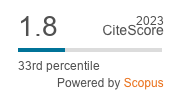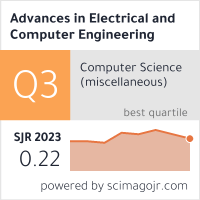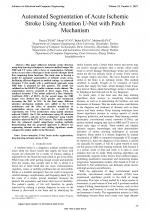| 1/2025 - 4 |
Automated Segmentation of Acute Ischemic Stroke Using Attention U-net with Patch MechanismCINAR, N. |
| Extra paper information in |
| Click to see author's profile in |
| Download PDF |
Author keywords
attention U-Net, brain stroke segmentation, deep learning, ischemic stroke, U-Net
References keywords
segmentation(32), stroke(17), brain(11), network(10), ischemic(10), lesion(9), attention(9), neural(7), multi(7), images(7)
Blue keywords are present in both the references section and the paper title.
About this article
Date of Publication: 2025-02-28
Volume 25, Issue 1, Year 2025, On page(s): 29 - 42
ISSN: 1582-7445, e-ISSN: 1844-7600
Digital Object Identifier: 10.4316/AECE.2025.01004
SCOPUS ID: 105001301554
Abstract
This paper addresses ischemic stroke detection using deep learning techniques to interpret medical images like MRI and CT scans, with a focus on segmentation. Ischemic stroke occurs when a blockage in brain arteries disrupts blood flow, impairing brain functions. The study aims to develop a model for automatic segmentation of ischemic stroke areas, facilitating efficient diagnosis in medical settings. An enhanced Attention U-Net model with a patch-based approach using MRI data is proposed for this purpose. The model was validated on the ISLES22 public ischemic stroke dataset. The segmentation process consisted of three stages. First, the standard Attention U-Net model achieved a Dice Similarity Coefficient (DSC) of 88.9%. In the second stage, the MRI images were divided into 32x32 patches and reanalyzed, increasing the DSC to 93%. In the final stage, different attention mechanism methods were added to the U-Net architecture and the effect of attention mechanism on segmentation success was observed. As a result of the experiments, the U-Net architecture using spatial attention achieved 94.86%, the U-Net architecture using SE attention achieved 95.40%, and the U-Net architecture using CBAM attention achieved 96.47% DCS success. The study concludes that the enhanced model outperforms existing methods, demonstrating that the proposed approach is effective for segmenting ischemic strokes and yielding significant results compared to similar studies in the literature. |
| References | | | Cited By «-- Click to see who has cited this paper |
| [1] S. Yahiya, A. Yousif, M. Bakri, Classification of Ischemic Stroke using Machine Learning Algorithms, Int. J. Comput. Appl. 149 (2016) 26-31. [CrossRef] [2] N. Tomita, S. Jiang, M. E. Maeder, S. Hassanpour, Automatic post-stroke lesion segmentation on MR images using 3D residual convolutional neural network, NeuroImage Clin. 27 (2020) 102276. [CrossRef] [Web of Science Times Cited 37] [SCOPUS Times Cited 56] [3] W. Yu, Z. Huang, J. Zhang, H. Shan, SAN-Net: Learning generalization to unseen sites for stroke lesion segmentation with self-adaptive normalization, Comput. Biol. Med. 156 (2023) 106717. [CrossRef] [Web of Science Times Cited 14] [SCOPUS Times Cited 26] [4] A. Clerigues, S. Valverde, J. Bernal, J. Freixenet, A. Oliver, X. Llado, Acute ischemic stroke lesion core segmentation in CT perfusion images using fully convolutional neural networks, Comput. Biol. Med. 115 (2019) 103487. [CrossRef] [Web of Science Times Cited 80] [SCOPUS Times Cited 105] [5] S. Qamar, H. Jin, R. Zheng, P. Ahmad, 3D Hyper-Dense Connected Convolutional Neural Network for Brain Tumor Segmentation, in: Proc. - 2018 14th Int. Conf. Semant. Knowl. Grids, SKG 2018, Institute of Electrical and Electronics Engineers Inc., 2018: pp. 123-130. [CrossRef] [Web of Science Times Cited 16] [SCOPUS Times Cited 19] [6] X. Zhang, C. Liu, N. Ou, X. Zeng, Z. Zhuo, Y. Duan, X. Xiong, Y. Yu, Z. Liu, Y. Liu, C. Ye, CarveMix: A simple data augmentation method for brain lesion segmentation, Neuroimage. 271 (2023). [CrossRef] [Web of Science Times Cited 14] [SCOPUS Times Cited 17] [7] M. Platscher, J. Zopes, C. Federau, Image translation for medical image generation: Ischemic stroke lesion segmentation, Biomed. Signal Process. Control. 72 (2022) 103283. [CrossRef] [Web of Science Times Cited 24] [SCOPUS Times Cited 34] [8] Y. Xue, F. G. Farhat, O. Boukrina, A. M. Barrett, J. R. Binder, U. W. Roshan, W. W. Graves, A multi-path 2.5 dimensional convolutional neural network system for segmenting stroke lesions in brain MRI images, NeuroImage Clin. 25 (2020) 102118. [CrossRef] [Web of Science Times Cited 45] [SCOPUS Times Cited 67] [9] Y. C. Wei, W. Y. Huang, C. Y. Jian, C. C. H. Hsu, C. C. Hsu, C. P. Lin, C. T. Cheng, Y. L. Chen, H. Y. Wei, K. F. Chen, Semantic segmentation guided detector for segmentation, classification, and lesion mapping of acute ischemic stroke in MRI images, NeuroImage Clin. 35 (2022) 103044. [CrossRef] [Web of Science Times Cited 7] [SCOPUS Times Cited 12] [10] L. Giancardo, A. Niktabe, L. Ocasio, R. Abdelkhaleq, S. Salazar-Marioni, S.A. Sheth, Segmentation of acute stroke infarct core using image-level labels on CT-angiography, NeuroImage Clin. 37 (2023) 103362. [CrossRef] [Web of Science Times Cited 6] [SCOPUS Times Cited 7] [11] R. Zoetmulder, L. Baak, N. Khalili, H.A. Marquering, N. Wagenaar, M. Benders, N. E. van der Aa, I. Isgum, Brain segmentation in patients with perinatal arterial ischemic stroke, NeuroImage Clin. 38 (2023). [CrossRef] [Web of Science Times Cited 7] [SCOPUS Times Cited 6] [12] A.R. Lee, I. Woo, D.W. Kang, S.C. Jung, H. Lee, N. Kim, Fully automated segmentation on brain ischemic and white matter hyperintensities lesions using semantic segmentation networks with squeeze-and-excitation blocks in MRI, Informatics Med. Unlocked. 21 (2020) 100440. [CrossRef] [SCOPUS Times Cited 9] [13] J. Walsh, A. Othmani, M. Jain, S. Dev, Using U-Net network for efficient brain tumor segmentation in MRI images, Healthc. Anal. 2 (2022) 100098. [CrossRef] [SCOPUS Times Cited 82] [14] N. Cinar, A. Ozcan, M. Kaya, A hybrid DenseNet121-U-Net model for brain tumor segmentation from MR Images, Biomed. Signal Process. Control. 76 (2022) 103647. [CrossRef] [Web of Science Times Cited 48] [SCOPUS Times Cited 70] [15] C. Han, J. Lin, J. Mai, Y. Wang, Q. Zhang, B. Zhao, X. Chen, X. Pan, Z. Shi, Z. Xu, S. Yao, L. Yan, H. Lin, X. Huang, C. Liang, G. Han, Z. Liu, Multi-layer pseudo-supervision for histopathology tissue semantic segmentation using patch-level classification labels, Med. Image Anal. 80 (2022) 102487. [CrossRef] [Web of Science Times Cited 62] [SCOPUS Times Cited 80] [16] O. Oktay, J. Schlemper, L. Le Folgoc, M. Lee, M. Heinrich, K. Misawa, K. Mori, S. McDonagh, N.Y. Hammerla, B. Kainz, B. Glocker, D. Rueckert, Attention U-Net: Learning Where to Look for the Pancreas, (2018). http://arxiv.org/abs/1804.03999 [17] M. R. Hernandez Petzsche, E. de la Rosa, U. Hanning, R. Wiest, W. Valenzuela, M. Reyes, M. Meyer, S. L. Liew, F. Kofler, I. Ezhov, D. Robben, A. Hutton, T. Friedrich, T. Zarth, J. Burkle, T. A. Baran, B. Menze, G. Broocks, L. Meyer, C. Zimmer, T. Boeckh-Behrens, M. Berndt, B. Ikenberg, B. Wiestler, J. S. Kirschke, ISLES 2022: A multi-center magnetic resonance imaging stroke lesion segmentation dataset, Sci. Data. 9 (2022) 1-9. [CrossRef] [Web of Science Times Cited 61] [SCOPUS Times Cited 84] [18] B. Lee, N. Yamanakkanavar, J.Y. Choi, Automatic segmentation of brain MRI using a novel patch-wise U-net deep architecture, PLoS One. 15 (2020) 1-20. [CrossRef] [Web of Science Times Cited 60] [SCOPUS Times Cited 79] [19] L. Borne, D. Riviere, M. Mancip, J. F. Mangin, Automatic labeling of cortical sulci using patch- or CNN-based segmentation techniques combined with bottom-up geometric constraints, Med. Image Anal. 62 (2020). [CrossRef] [Web of Science Times Cited 45] [SCOPUS Times Cited 47] [20] F. Ullah, A. Salam, M. Abrar, F. Amin, Brain Tumor Segmentation Using a Patch-Based Convolutional Neural Network: A Big Data Analysis Approach, Mathematics. 11 (2023) 1-18. [CrossRef] [Web of Science Times Cited 14] [SCOPUS Times Cited 23] [21] D. Franco-Barranco, A. Munoz-Barrutia, I. Arganda-Carreras, Stable Deep Neural Network Architectures for Mitochondria Segmentation on Electron Microscopy Volumes, Neuroinformatics. 20 (2022) 437-450. [CrossRef] [Web of Science Times Cited 20] [SCOPUS Times Cited 18] [22] R. Yousef, S. Khan, G. Gupta, T. Siddiqui, B. M. Albahlal, S. A. Alajlan, M. A. Haq, U-Net-Based Models towards Optimal MR Brain Image Segmentation, Diagnostics. 13 (2023). [CrossRef] [Web of Science Times Cited 52] [SCOPUS Times Cited 66] [23] K. Trebing, T. Stanczyk, S. Mehrkanoon, Smart-U-Net: Precipitation nowcasting using a small Attention U-Netarchitecture, Pattern Recognit. Lett. 145 (2021) 178-186. [CrossRef] [Web of Science Times Cited 266] [SCOPUS Times Cited 315] [24] D. Franco-Barranco, A. Munoz-Barrutia, I. Arganda-Carreras, Stable Deep Neural Network Architectures for Mitochondria Segmentation on Electron Microscopy Volumes, Neuroinformatics. 20 (2022) 437-450. [CrossRef] [Web of Science Times Cited 20] [SCOPUS Times Cited 18] [25] J. Wang, X. Zhang, P. Lv, H. Wang, Y. Cheng, Automatic Liver Segmentation Using EfficientNet and Attention-Based Residual U-Net in CT, J. Digit. Imaging. 35 (2022) 1479-1493. [CrossRef] [Web of Science Times Cited 14] [SCOPUS Times Cited 17] [26] X. Tong, J. Wei, B. Sun, S. Su, Z. Zuo, P. Wu, Ascu-net: Attention gate, spatial and channel attention u-net for skin lesion segmentation, Diagnostics. 11 (2021). [CrossRef] [Web of Science Times Cited 84] [SCOPUS Times Cited 117] [27] Y. Yu, S. Chen, H. Wei, Modified U-Net with attention gate and dense skip connection for flow field information prediction with porous media, Flow Meas. Instrum. 89 (2023) 102300. [CrossRef] [Web of Science Times Cited 16] [SCOPUS Times Cited 18] [28] M. H. Guo, T. X. Xu, J. J. Liu, Z. N. Liu, P. T. Jiang, T. J. Mu, S. H. Zhang, R. R. Martin, M. M. Cheng, S. M. Hu, Attention mechanisms in computer vision: A survey, Comput. Vis. Media. 8 (2022) 331-368. [CrossRef] [Web of Science Times Cited 1311] [SCOPUS Times Cited 1674] [29] L. Rundo et al., "USE-Net: Incorporating Squeeze-and-Excitation blocks into U-Net for prostate zonal segmentation of multi-institutional MRI datasets", Neurocomputing, vol. 365, pp. 31-43, Nov. 2019. [30] S. Ucan, M. Ucan, and M. Kaya, "Deep learning based approach with EfficientNet and SE block attention mechanism for multiclass Alzheimer's disease detection", in 2023 4th International Conference on Data Analytics for Business and Industry (ICDABI), Bahrain, 2023, pp. 285-289. [31] Y. Zhang, Q. Zhang, J. Gu, H. Yu, and D. Xu, "U-net model based on cbam attention mechanism for Coronary Angiography segmentation", J. Mech. Med. Biol., vol. 24, no. 09, Nov. 2024. [32] H. A. Shah and J.-M. Kang, "An optimized multi-organ cancer cells segmentation for histopathological images based on CBAM-residual U-net", IEEE Access, vol. 11, pp. 111608-111621, 2023. [33] D. Alis, M. Yergin, C. Alis, C. Topel, O. Asmakutlu, O. Bagcilar, Y.D. Senli, A. Ustundag, V. Salt, S.N. Dogan, M. Velioglu, H.H. Selcuk, B. Kara, I. Oksuz, O. Kizilkilic, E. Karaarslan, Inter-vendor performance of deep learning in segmenting acute ischemic lesions on diffusion-weighted imaging: a multicenter study, Sci. Rep. 11 (2021) 1-10. [CrossRef] [Web of Science Times Cited 11] [SCOPUS Times Cited 15] [34] S. Li, J. Zheng, D. Li, Precise segmentation of non-enhanced computed tomography in patients with ischemic stroke based on multi-scale U-Net deep network model, Comput. Methods Programs Biomed. 208 (2021) 106278. [CrossRef] [Web of Science Times Cited 19] [SCOPUS Times Cited 20] [35] G. B. Praveen, A. Agrawal, P. Sundaram, S. Sardesai, Ischemic stroke lesion segmentation using stacked sparse autoencoder, Comput. Biol. Med. 99 (2018) 38-52. [CrossRef] [Web of Science Times Cited 50] [SCOPUS Times Cited 64] [36] K. K. Wong, J. S. Cummock, G. Li, R. Ghosh, P. Xu, J.J. Volpi, S.T.C. Wong, Automatic Segmentation in Acute Ischemic Stroke: Prognostic Significance of Topological Stroke Volumes on Stroke Outcome, Stroke. 53 (2022) 2896-2905. [CrossRef] [Web of Science Times Cited 24] [SCOPUS Times Cited 26] [37] J. Wu, X. Tang, Brain segmentation based on multi-atlas and diffeomorphism guided 3D fully convolutional network ensembles, Pattern Recognit. 115 (2021) 107904. [CrossRef] [Web of Science Times Cited 40] [SCOPUS Times Cited 41] [38] Z. Wu, X. Zhang, F. Li, S. Wang, L. Huang, and J. Li, "W-Net: A boundary-enhanced segmentation network for stroke lesions", Expert Syst. Appl., vol. 230, no. 120637, p. 120637, Nov. 2023. Web of Science® Citations for all references: 2,467 TCR SCOPUS® Citations for all references: 3,232 TCR Web of Science® Average Citations per reference: 63 ACR SCOPUS® Average Citations per reference: 83 ACR TCR = Total Citations for References / ACR = Average Citations per Reference We introduced in 2010 - for the first time in scientific publishing, the term "References Weight", as a quantitative indication of the quality ... Read more Citations for references updated on 2025-06-04 10:02 in 242 seconds. Note1: Web of Science® is a registered trademark of Clarivate Analytics. Note2: SCOPUS® is a registered trademark of Elsevier B.V. Disclaimer: All queries to the respective databases were made by using the DOI record of every reference (where available). Due to technical problems beyond our control, the information is not always accurate. Please use the CrossRef link to visit the respective publisher site. |
Faculty of Electrical Engineering and Computer Science
Stefan cel Mare University of Suceava, Romania
All rights reserved: Advances in Electrical and Computer Engineering is a registered trademark of the Stefan cel Mare University of Suceava. No part of this publication may be reproduced, stored in a retrieval system, photocopied, recorded or archived, without the written permission from the Editor. When authors submit their papers for publication, they agree that the copyright for their article be transferred to the Faculty of Electrical Engineering and Computer Science, Stefan cel Mare University of Suceava, Romania, if and only if the articles are accepted for publication. The copyright covers the exclusive rights to reproduce and distribute the article, including reprints and translations.
Permission for other use: The copyright owner's consent does not extend to copying for general distribution, for promotion, for creating new works, or for resale. Specific written permission must be obtained from the Editor for such copying. Direct linking to files hosted on this website is strictly prohibited.
Disclaimer: Whilst every effort is made by the publishers and editorial board to see that no inaccurate or misleading data, opinions or statements appear in this journal, they wish to make it clear that all information and opinions formulated in the articles, as well as linguistic accuracy, are the sole responsibility of the author.



